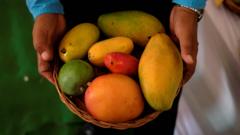As India grapples with an escalating obesity crisis—projected to affect 450 million citizens by 2050—the societal perception of the pot belly shifts from a mark of wealth to a serious health danger. A deep dive into abdominal obesity, its implications, and necessary lifestyle adaptations reveals alarming statistics and medical insights.
The Evolving Perception of Abdominal Obesity in India: A Health Crisis Unveiled

The Evolving Perception of Abdominal Obesity in India: A Health Crisis Unveiled
The pot belly, once a symbol of prosperity in India, is now recognized as a significant health threat amid rising obesity levels.
The pot belly in India has undergone a dramatic transformation in societal perception. Once a proud reflection of wealth and comfort, it has emerged as a serious health concern as the country grapples with an obesity epidemic that threatens millions. In 2021, India reported 180 million overweight or obese adults, second only to China, prompting warnings that this could rise to 450 million by 2050, encompassing nearly a third of the population.
Abdominal obesity, which is characterized by excessive fat accumulation around the belly, extends beyond mere aesthetic issues. Studies have historically indicated a direct association between belly fat and serious chronic conditions, such as Type 2 diabetes and heart disease. The recent National Family Health Survey (NFHS-5) has brought stark conclusions to light, showing that around 40% of women and 12% of men in India are now grappling with abdominal obesity, defined as a waist measurement exceeding 90 cm for men and 80 cm for women.
In cities, the trend is even more pronounced, with urban dwellers exhibiting higher waist measurements indicative of health risks. The health implications of abdominal fat are alarming, primarily due to its role in causing insulin resistance—a condition that hampers the body’s ability to manage blood sugar effectively.
Notably, South Asians are more vulnerable due to their unique body fat distribution traits. With fat accumulating more readily around the trunk and less efficiently in deeper abdominal regions, vital organs such as the liver face increased risks. The evolutionary backdrop—shaped by centuries of famine—has left South Asians with a predisposition for survival that now manifests in detrimental health outcomes.
Researchers have now begun redefining obesity guidelines specifically for Asian Indians, emphasizing the need to recognize abdominal fat and adjust treatment strategies accordingly. The adoption of lifestyle changes has been deemed crucial, with experts suggesting a higher threshold for physical activity—250 to 300 minutes weekly—for Indians as opposed to the 150 minutes recommended for Europeans.
Life choices play a pivotal role in this obesity epidemic, with rising consumption of processed foods and sedentary lifestyles to blame. Observations indicate a troubling rise in the preference for convenience over healthy eating habits, raising concerns about the long-term implications.
As the pot belly transforms from a humorous caricature in media to a serious health warning, it is imperative that concerted action is taken towards awareness, prevention, and treatment. For India, the pot belly is not just a matter of personal lifestyle; it represents a looming public health crisis.






















